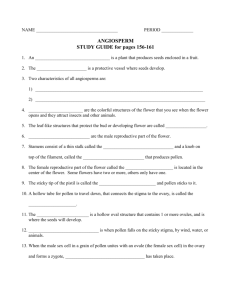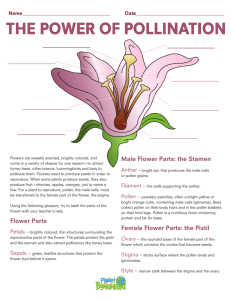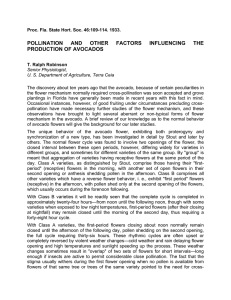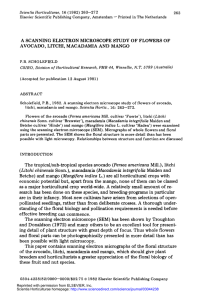THE REMARKABLE AVOCADO FLOWER
advertisement
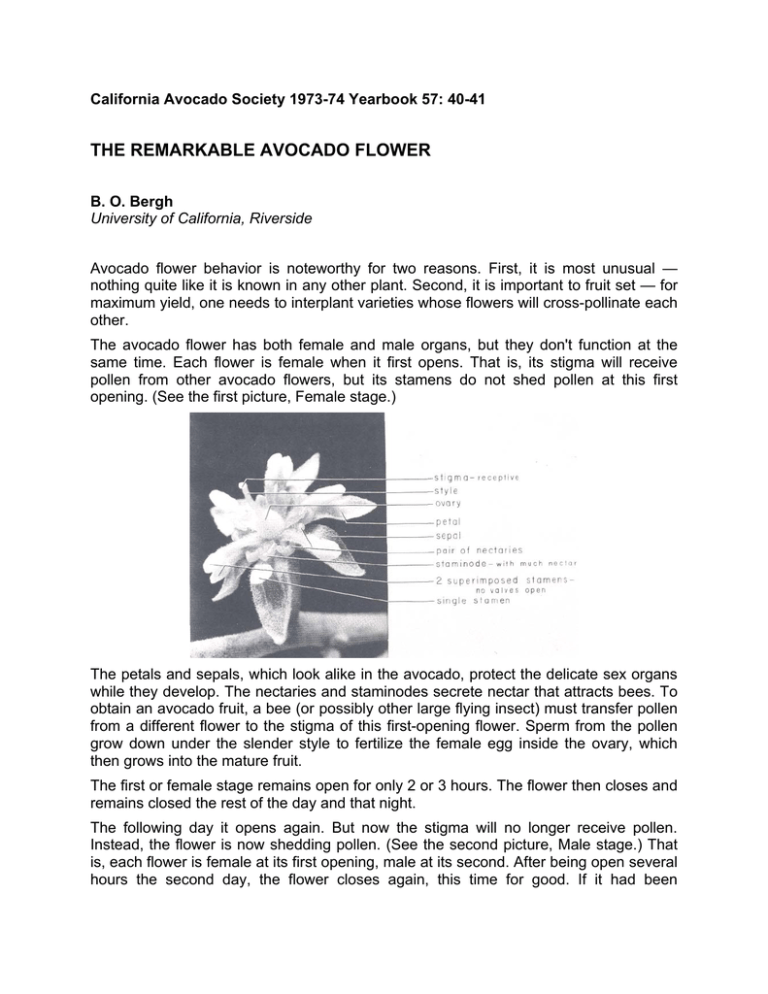
California Avocado Society 1973-74 Yearbook 57: 40-41 THE REMARKABLE AVOCADO FLOWER B. O. Bergh University of California, Riverside Avocado flower behavior is noteworthy for two reasons. First, it is most unusual — nothing quite like it is known in any other plant. Second, it is important to fruit set — for maximum yield, one needs to interplant varieties whose flowers will cross-pollinate each other. The avocado flower has both female and male organs, but they don't function at the same time. Each flower is female when it first opens. That is, its stigma will receive pollen from other avocado flowers, but its stamens do not shed pollen at this first opening. (See the first picture, Female stage.) The petals and sepals, which look alike in the avocado, protect the delicate sex organs while they develop. The nectaries and staminodes secrete nectar that attracts bees. To obtain an avocado fruit, a bee (or possibly other large flying insect) must transfer pollen from a different flower to the stigma of this first-opening flower. Sperm from the pollen grow down under the slender style to fertilize the female egg inside the ovary, which then grows into the mature fruit. The first or female stage remains open for only 2 or 3 hours. The flower then closes and remains closed the rest of the day and that night. The following day it opens again. But now the stigma will no longer receive pollen. Instead, the flower is now shedding pollen. (See the second picture, Male stage.) That is, each flower is female at its first opening, male at its second. After being open several hours the second day, the flower closes again, this time for good. If it had been successfully pollinated at the first opening, and if other conditions are right, it will develop into a delicious, money-bringing fruit. Nature has provided for avocado cross-pollination by creating varieties of two kinds. The "A" type is female in the morning of the first day and male in the afternoon of the second day (when the weather is warm). The "B" type is the reverse: its flowers are female in the afternoon and male the following morning. So the two types complement each other — a variety of one type provides pollen when a variety of the other type needs it. For one flower of each variety, the timing will be as follows: First Day Morning Afternoon “A” Type: “B” Type Second Day Morning Afternoon Female Male Female Male But with hundreds of flowers opening in both stages day after day, the daily situation becomes: “A” Type: “B” Type Morning Afternoon Female Male Male Female And so we get our necessary pollination. The two flowering types behave with clock-like exactness only when the average temperature (night minimum and day maximum) is above about 70°. As temperatures fall, the daily openings become delayed and become irregular, so that a single tree may have flowers in both female and male stages at the same time. This explains how large blocks of just one variety sometimes set heavy crops. But as the average temperature falls below about 70°, the flower parts function less well. Below about 60°, there may be zero set. In every case where we have studied it, cross-pollination has resulted in increased fruit set. This requires an "A" and a "B" variety growing with their branches over-lapping or at least close together. Some varieties: "A": Alboyce, Anaheim, Hass, Jalna, MacArthur, Reed, Rincón, Topa, Yama. "B": Bacon, Clifton, Edranol, Ettinger, Fuerte, Marshelline, Nabal, Zutano.




